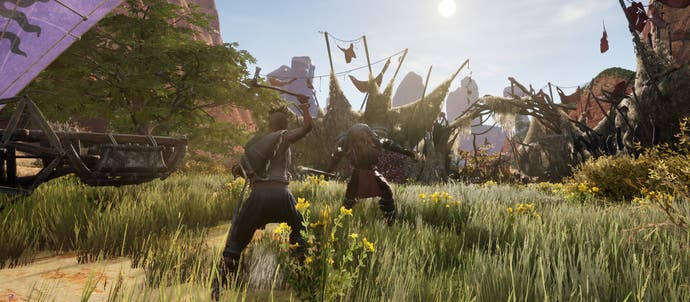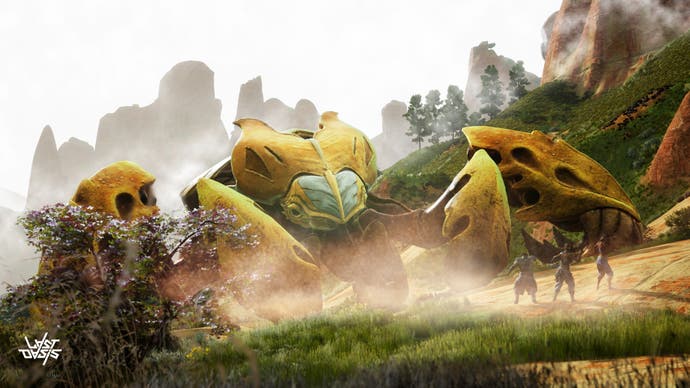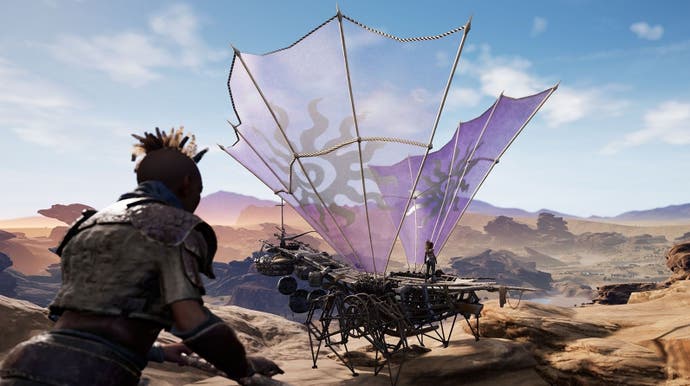Mortal Engines-style game Last Oasis aims to solve the survival genre's problems
Been there, dune that.
Remember the Mortal Engines film that came out a few years ago? Me neither, but something that could scratch that itch for massive roving machines is on its way, as Last Oasis is heading into early access this week - and I've had an early look via an online press demo.
First unveiled in January last year, Last Oasis is a post-apocalyptic MMO survival game with an enticing hook: you're a nomad in a vast desert which can be traversed with rickety wooden walkers, sent out by society to collect resources and ensure humanity's survival. The lore behind this explains that Earth's rotation has stopped, meaning the planet is split into fiery desert and extreme cold, with a small sliver of hospitable land in the middle. As the sun moves, the nomads must also travel to avoid the burning rays. It's a clever backstory, but is it enough to separate it from the crowd of other survival MMOs?
During the early stages, Last Oasis shares many of the mechanics you'd expect to see in survival games like Rust: harvesting wood, crafting better tools, and a tech tree that can be expanded with technology gathered from old wrecks and settlements. While ranged combat is an option on the walkers, we were also shown hand-to-hand melee, which aims to provide more depth than other survival games by tracking whether players click on the right or left-hand side of the screen, with melee hits corresponding to these in-game. As the same mechanic works for blocking, it means there's some level of reflexive skill rather than just spamming - and a stamina bar means you'll have to deploy your hits carefully.
Thankfully things get interesting quite early on - your first machine, an insect-style walker, doesn't require too many materials and plays a key role in allowing you to explore the vast environment (and providing a valuable respawn point). Players load into hexagonal worlds called oases, which in turn connect to a bunch of others across the globe as part of a larger world map. To travel between these is quick, but requires water, a valuable resource which also powers the machines you use to climb over sand dunes and find more resources. Early-stage walkers can't hold an awful lot of water, and therefore can't take you very far, prompting players to search for ways to upgrade or swap their machines. You get the idea.

As all the tiles and servers are connected across the globe (allowing European and American players to intermingle, for instance) I was a little worried about potential latency problems, but Donkey Crew project lead Florian Hofreither assured me this wouldn't be an issue.
"We don't expect overly-large issues because we've been busy from day one making sure that performance is great," he told me. "With all survival games out there, we've noticed that when lag comes in at crucial moments it's just not a great experience. So we decided to cap our servers at 100 people per server, and doing our tests we've seen no issues."
The walkers themselves are by far the most enticing aspect of Last Oasis: there's something really satisfying about their movement, along with the clacking and groaning noises they produce. In total, there are 13 types of walker for players to choose from, some of which are better suited for certain tasks (such as attacking or moving cargo). All of them can be customised with extra parts at stationary trading posts - including slingshot cannons and darts, with options to power movement with either pedals or wings. The larger ones can provide useful shelter if attacking other players, or better stability and health for fighting massive monsters in hunting parties. Killing said creatures brings in some serious rewards - although you'll have to put up with being shaken about, as unfortunately the big monster fight felt a little nauseating when watching the demo.

Rather promisingly, it seems the devs have gone to great efforts to dial back the sort of griefing that undermines other PvP survival games, while also maintaining some level of danger. Offline raiding isn't an option, while player-clans are given incentives to protect players that come into their territory.
"The way it works is if you are on a region that is owned by a clan, then the clan will welcome you," project lead Florian Hofreither said in response. "The reason is because a part of your resources goes to the clan as a passive income. However, that is only true if you stay alive - once you get murdered, the clan loses your bonus. It doesn't affect you as a solo player, but the clan will try to make sure that as many players as possible stay alive on their territory. This is interesting because clans will never hunt in their own territory because they will damage themselves, and they would much rather hunt in the territory of enemy clans where they can damage them."
If being an asshole really is your thing, however, there are still opportunities for you - a little like the way space is controlled in Eve Online, there are territories which are uncontrolled by clans where players can effectively become pirates and hunt other players without consequences. Well, unless that player has a bigger walker. But in theory, this means solo players should be able to avoid more hostile regions if they wish.

Overall, I'm still intrigued by the idea of roaming the wastes on the back of a crawling wooden structure (and the possibility of building a walker armada) - but I do have a couple of reservations. Namely, it's difficult to see exactly how Last Oasis will work once handed over to a larger community, particularly as much of the game seems reliant on player-driven content. While we got a brief glimpse at the player-driven economy at a trading post, it's hard to know exactly how this (or the endgame) will work out in practice until thousands of players get their hands on it. And although the devs emphasised it's quick to travel and there are multiple biomes, I do wonder whether this game will end up feeling a little empty by virtue of being, well, a big old desert. Will there be enough to keep me entertained beyond constructing and driving my first few walkers? In any case, we'll find out when Last Oasis enters Steam Early Access on 26th March, and as it develops over the coming years.


